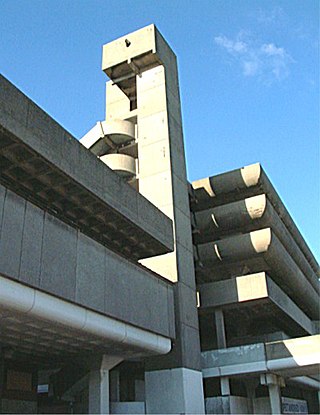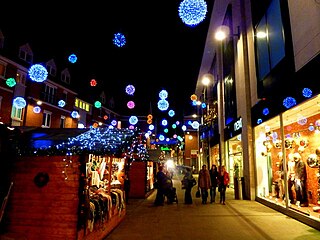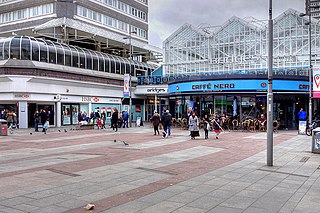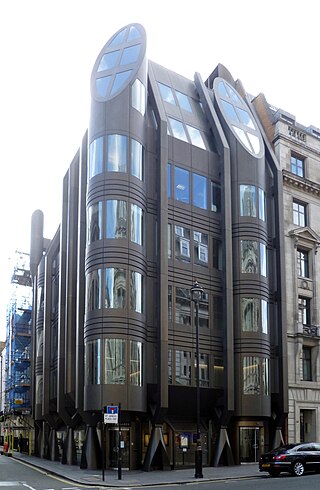
Newcastle upon Tyne, or simply Newcastle, is a cathedral city and metropolitan borough in Tyne and Wear, England. It is located on the River Tyne's northern bank, opposite Gateshead to the south. It is the most populous settlement in the Tyneside conurbation and North East England.

The Tricorn Centre was a shopping, nightclub and car park complex in Portsmouth, Hampshire, England. It was designed in the Brutalist style by Owen Luder and Rodney Gordon and took its name from the site's shape which from the air resembled a tricorn hat. Constructed in the mid-1960s, it was demolished in 2004. It was home to one of the first Virgin Megastores and housed the largest Laser Quest arena in Europe.

Get Carter is a 1971 British gangster film, written and directed by Mike Hodges in his directorial debut and starring Michael Caine, Ian Hendry, John Osborne, Britt Ekland and Bryan Mosley. Based on Ted Lewis's 1970 novel Jack's Return Home, the film follows the eponymous Jack Carter (Caine), a London gangster who returns to his hometown in North East England to learn about his brother's supposedly accidental death. Suspecting foul play, and with vengeance on his mind, he investigates and interrogates, regaining a feel for the city and its hardened-criminal element.

Gateshead is a town in the Gateshead Metropolitan Borough of Tyne and Wear, England. It is on the River Tyne's southern bank. The town's attractions include the twenty metre tall Angel of the North sculpture on the town's southern outskirts, The Glasshouse International Centre for Music and the Baltic Centre for Contemporary Art. The town shares the Millennium Bridge, Tyne Bridge and multiple other bridges with Newcastle upon Tyne.
Killingworth, formerly Killingworth Township, is a town in North Tyneside, Tyne and Wear, England. It lies within the historic county of Northumberland.

Harold Owen Luder was a British architect who designed a number of notable and sometimes controversial buildings in the United Kingdom in the 1960s and 1970s, many now demolished. He served as chairman of the Architects Registration Board and twice as President of the Royal Institute of British Architects in 1981–1983 and 1995–1997. He established his own practice Owen Luder Partnership in 1957, and left in 1987 to form the consultancy Communication In Construction.

Blaydon is a town in the Metropolitan Borough of Gateshead, Tyne and Wear, England, and historically in County Durham. Blaydon, and neighbouring Winlaton, which Blaydon is now contiguous with, form the town of Blaydon-on-Tyne. The Blaydon/Winlaton ward had a population in 2011 of 13,896.

Eldon Square is a shopping centre in Newcastle upon Tyne, England. It opened in 1976 and was built on the site of Old Eldon Square, a famous part of Georgian Newcastle designed by John Dobson in about 1824. This redevelopment, which left only the eastern terrace standing, has been criticised, with one writer calling it "the greatest single example of architectural vandalism in Britain since the war".

Kingston Park is a suburb of Newcastle upon Tyne, about 4 miles (6 km) north west of the city centre.

Dunston is a western area of the town of Gateshead on the south bank of the River Tyne, in the Metropolitan Borough of Gateshead, North East England. Dunston had a population of 18,326 at the 2011 Census.

Gosforth is an affluent suburb of the city and metropolitan borough of Newcastle upon Tyne, in the county of Tyne and Wear, England. It constituted a separate urban district from 1895 until 1974 before officially merging with the city of Newcastle upon Tyne. In 2001, it had a population of 23,620.
Demolition is a 2005 television series from Channel 4, which can be seen as being the reverse of the BBC's 2003 series Restoration. The public were encouraged to vote for buildings which they want demolished and replaced, with 12 buildings making The Dirty Dozen.

Gateshead Interchange is a Tyne and Wear Metro station, serving the town of Gateshead in Tyne and Wear, England. It joined the network on 15 November 1981, following the opening of the third phase of the network, between Haymarket and Heworth.

Whitefriars Shopping Centre is a shopping centre in Canterbury, Kent.

Runcorn Shopping City, formerly Halton Lea and Runcorn Shopping Centre, is a medium-sized indoor shopping centre in Runcorn, England. Opened by Queen Elizabeth II in 1972, it is the main shopping area in Runcorn and has over 125,000 visitors per week. It was the largest enclosed shopping centre in Europe at the time of its construction and remains the largest in Cheshire.
Thomas Oliver was an English classical architect and surveyor active in Newcastle upon Tyne. He was one of a number of talented local architects who worked with Richard Grainger on the development of Newcastle, but his work tends to be overshadowed by that of John Dobson who has been given a great deal of the credit for the central part of the city referred to as Grainger Town.

The Bridges Shopping Centre, commonly known as ‘The Bridges’ is a shopping centre located in Sunderland, England. The centre was opened by Princess Royal, Anne in 1988.

Newcastle City Centre is the city centre district of Newcastle upon Tyne, England. It is the historical heart of the city and serves as the main cultural and commercial centre of the North East England region. The city centre forms the core of the Tyneside conurbation.

Rodney H Gordon was an English architect. He was the primary architect of the Tricorn Centre, Portsmouth, and Trinity Square, Gateshead. Architecturally, his works were primarily in concrete; he was said to be a Brutalist and his buildings have been described as "dramatic, sculptural and enormous" as well as "futuristic".

Derwent Tower was a 29-storey residential apartment building in Dunston, Tyne and Wear, United Kingdom, opened in 1972. Due to its unusual shape it was nicknamed the "Dunston Rocket" during construction and the name remained with locals throughout its life. It was demolished in 2012.




















